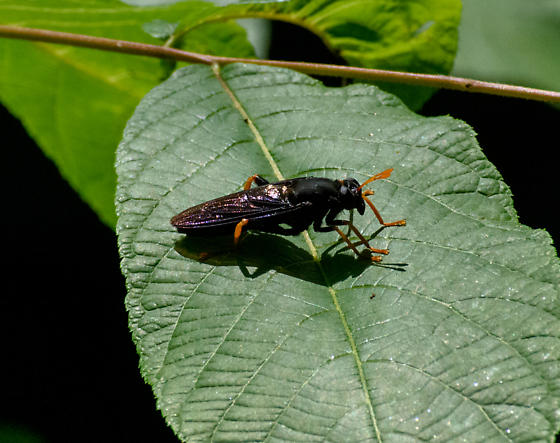Michigan insects in the garden – Season 2 Week 10: Mydas flies
Mydas flies are large Michigan flies that mimic wasps.

When first seeing a mydas fly, you will likely step away believing this is a large wasp. However, this harmless fly is actually a strongly believable wasp-mimic with the right colors, long and thin antennae, and wing-flicking behaviors. At nearly an inch in length, this is one of the best wasp mimics in Michigan, being confused for great black wasps, great golden digger wasps and other wasps in the Pomipilidae family.
Pompilids are known for hunting and paralyzing spiders as prey. Though mydas flies are the largest flies, not much is known about their biology due to their rarity in the wild and rapid flight patterns. One of the world’s largest flies, at 2 inches in length, belongs to the Mydid family in South America. Approximately 80 species exist in North America, with three times as many in Central and South America.
Mydas fly species in Michigan
Michigan State University’s Albert J. Cook Insect Collection has records of two species, Mydas clavatus and Mydas tibialis. Online records from other citizen science reporting tools suggest at least two or more additional species could be present in the state. With orange on its second abdominal segment, M. clavatus (Photo 1) is the most common species in the state. They are active in July through August in a variety of habitats in southeast Michigan. This species is distributed throughout the eastern U.S. and continues to expand its range westward to states such as Colorado. M. tibialis is all black with orange on the wings and antennae (Photo 2) and will even fool entomologists into thinking it is a pompilid wasp.

When approached, mydas flies will often fly away, making them a difficult subject to photograph. If you come across a dead mydas fly, the adults are identified by a four-segmented antennae that widens into a “club” at its end and through particular patterns on the wings.
What do mydas flies do?
The mydas fly spends much of its live in the soil or decaying wood as a larva. During this time, they are are predators of soil-dwelling insects including grubs. Mydas flies pupate in the soil and use spines on the outside of the pupae to maneuver to the surface before adulthood. There is debate if adults are predators or nectar feeders. One report, “Adult Female Mydas Clavatus (Diptera: Mydidae) Feeding on Flowers in Wisconsin,” identifies them feeding on flowers such as beebalm, milkweed and verbena. Adults are more likely to occur in forested or grassy areas, although are also sometimes found on playground woodchips.
The genus name, Mydas, comes from its connection to the golden touch of King Midas in Greek mythology. Though this group of flies won’t turn everyday objects into gold, gardeners can be mesmerized by the golden, orange color on the abdomen of several mydas fly species.



 Print
Print Email
Email





